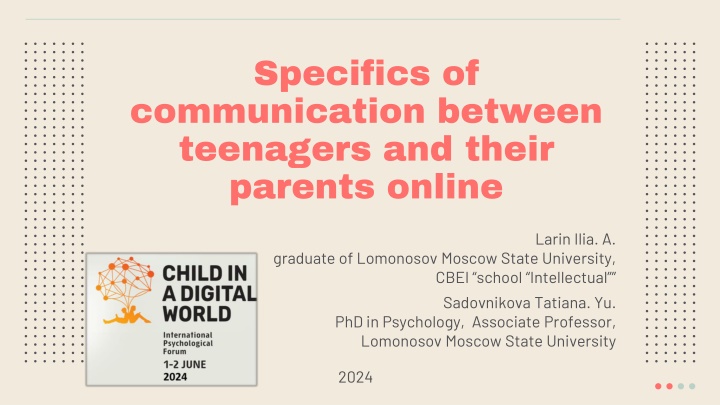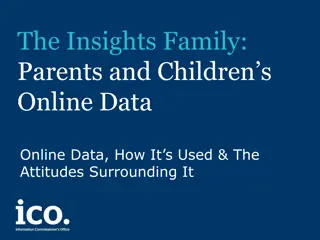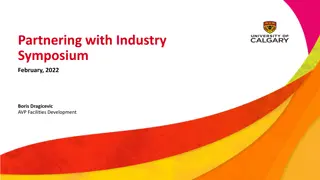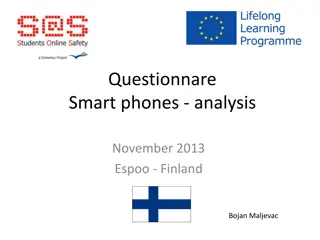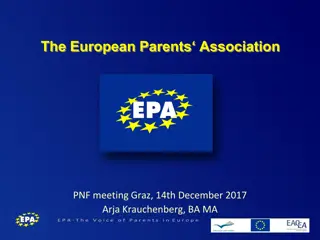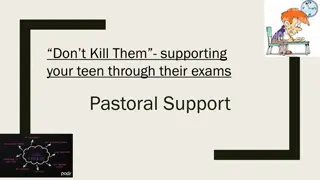Specifics of Teenagers' Communication with Parents Online: Study Insights
Global societal changes impact the communication dynamics between teenagers and parents, especially online. This study explores the communication needs of adolescents, both online and offline, through a modified questionnaire assessing various aspects such as the need for relationships, empathy, support, and knowledge exchange. The sample included 128 individuals from schools in Moscow and the surrounding region, providing valuable insights into the evolving parent-teen communication landscape in the digital age.
Download Presentation

Please find below an Image/Link to download the presentation.
The content on the website is provided AS IS for your information and personal use only. It may not be sold, licensed, or shared on other websites without obtaining consent from the author.If you encounter any issues during the download, it is possible that the publisher has removed the file from their server.
You are allowed to download the files provided on this website for personal or commercial use, subject to the condition that they are used lawfully. All files are the property of their respective owners.
The content on the website is provided AS IS for your information and personal use only. It may not be sold, licensed, or shared on other websites without obtaining consent from the author.
E N D
Presentation Transcript
Specifics of communication between teenagers and their parents online Larin Ilia. A. graduate of Lomonosov Moscow State University, CBEI school Intellectual Sadovnikova Tatiana. Yu. PhD in Psychology, Associate Professor, Lomonosov Moscow State University 2024
Relevance Global changes in society and children's development impact the main institution for children's upbringing -the family Online Information and computer technologies (ICT) affect every stage of children's development communication between adolescents and their parents still is poorly investigated
Methods The authorial modified version of the "Incomplete Sentences (J.Sacks- S.Levy) focused on the communication between adolescents and their parents online and offline The customized (authorial) Questionnaire of adolescents needs to communicate with their parents online and offline (QANCP)
Questionnaire of adolescents needs to communicate with their parents online and offline (QANCP) The structure of the questionnaire includes two main scales assessing the overall level of need for communication, "online" and "offline", as well as nine subscales measuring the severity of specific communicative needs in offline and online communication.
5 the need for another person and the need for relationships with another person (RPer); the need for belonging to social community (BCom); the need for co-experience and empathy (Emp); the need for care, assistance, and support from others (Sup); the need for providing assistance, care, and support to others (PrSup); the need for establishment of business links for joint activities and cooperation (JAct); the need for constant exchange of experience, knowledge (Exch); the need for assessment by others, respect, authority (Resp); the need for developing an understanding and explanation of the objective situation and everything that happens in it (In Com) in common with other people. 1. 2. 3. 4. 5. Online 6. 7. Offline 8. 9.
A sample of the study The sample consisted of 128 people: 56 boys, 72 girls Students of schools in Moscow and the Moscow region of senior adolescence (15-17 years old) Sample of the study 44 % 56 % boys girls
Results (QANCP) Online communication Offline communication Stand. Deviation Stand. deviation Mean Mean Communicative need 7,5 2,00 5,69 2,48 For relationship For belonging to soc. community Calculating the Wilcoxon coefficient to compare the communicative needs of adolescents and their parents in "online" and "offline" communication, significant differences were found (p=0.000in all cases). 7,47 2,42 4,52 2,60 6,33 2,62 4,25 2,47 For empathy 7,16 2,50 4,78 2,65 For care and support For providing support to others 7,03 2,31 5,25 2,70 7,52 2,13 7,77 2,51 For joint activities 7,21 2,26 4,81 2,40 For exchange of experience For assessment by others, respect For developing and explanation of the common situation 6,89 2,26 5,34 2,46 7,01 2,41 4,63 2,42 64,11 15,33 47,04 17,24 General communicative need
Results "Incomplete Sentences Adolescents generally assess online communication with their parents as less emotional t han offline commu nication. In addition, they rate the sphere of online communication as "safer" Online Adolescents still prefer to discuss emotionally significant issues with their parents in person, leaving online for less emotionally significant topics communication is often used to "quickly transfer the necessary information", to communicate your location, and to solve everyday issues The favorite way to communicate with parents for the vast majority of teenagers is "offline".
Conclusion Thus, while the online environment may be subjectively safer for adolescents when communicating with their parents about less significant topics, adolescents still need emotional support from adults for personally significant problems. As a result, offline communication with parents remains a priority for them. We plan to conduct further research on this topic, focusing on the detailed description of the phenomenon of communication between adolescents and their parents online.
10 References Belinskaia, E.P. & Gavrichenko, O.V. (2018). Samoprezentatsiiav virtual'nomprostranstve: fenomenologiiai zakonomernosti. Psikhologicheskieissledovaniia, 11(60), 12 22. https://doi.org/10.54359/ps.v11i60.269 Larin, I.A., & Sadovnikova, T.Yu. (2023). Obshcheniepodrostkovs roditeliami"onlain' i"oflain': issledovanies pomoshch'iumetodafokus-grupp// Anan'evskiechteniia 2023. Chelovekv sovremennommire: potentsialyiperspektivypsikhologiirazvitiia (pp. 123 124). Scythia-print Publishing House St. Petersburg Marisova, L.I. (1978). O motivatsionno-potrebnostnoiosnoveobshcheniia[About the motivational and need basis of communication]. Soldatova, G.U., & Voiskunskii, A.E. (2021). Sotsial'no-kognitivnaiakontseptsiiatsifrovoi sotsializatsii: novaiaekosistema isotsial'naiaevoliutsiia. ZhurnalVysshei shkolyekonomiki, 18(3), 431 450. https://doi.org/10.17323/1813-8918-2021-3-431-450 Soldatova, G.U., Chigarkova, S.V., & Ilyukhina, S.N. (2022) Predstavleniiao real'nomi virtual'nomprostranstvakhkakchast' aktual'noikartinymirapodrostkoviroditeleiv tsifrovom obshchestve: vozmozhnostiadaptatsii. VestnikSankt-Peterburgskogouniversiteta., 12(3), 226 248. https://doi.org/10.21638/spbu16.2022.301
